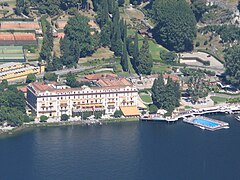Villa d'Este (Cernobbio)
| Villa d'Este | |
|---|---|

Villa d'Este as seen from Brunate
|
|
| General information | |
| Architectural style | Classic |
| Location | Cernobbio, Italy |
| Website | |
| http://www.villadeste.com | |
Coordinates: 45°50′41.91″N 9°4′47.64″E / 45.8449750°N 9.0799000°E
The Villa d'Este, originally Villa del Garovo, is a Renaissance patrician residence in Cernobbio on the shores of Lake Como, northern Italy. Both the villa and the 25-acre (100,000 m2) park which surrounds it have undergone significant changes since their sixteenth-century origins as a summer residence for the Cardinal of Como. Nevertheless, visiting the garden in 1903 for Century Magazine, Edith Wharton found this to be the ‘the only old garden on Como which keeps more than a fragment of its original architecture’, and noted that ‘though Queen Caroline anglicised part of the grounds, the main lines of the Renaissance garden still exist’.
Since 1873 the complex has been a luxury hotel.
Gerardo Landriani, Bishop of Como (1437–1445), founded a female convent here at the mouth of the Garovo torrent in 1442. A century later Cardinal Tolomeo Gallio demolished the nunnery and commissioned Pellegrino Tibaldi to design a residence for his own use. The Villa del Garovo, together with its luxuriant gardens, was constructed during the years 1565–70 and during the cardinal’s lifetime it became a resort of politicians, intellectuals and ecclesiastics. On Gallio’s death the villa passed to his family who, over the years, allowed it to sink into a state of some decay. From 1749 to 1769 it was a Jesuit centre for spiritual exercises, after which it was acquired first by Count Mario Odescalchi and then in 1778 by a Count Marliani. In 1784 it passed to the Milanese Calderari family who undertook a major restoration project and created a new park all’Italiana with an impressive nymphaeum and a temple displaying a seventeenth-century statue of Hercules hurling Lichas into the sea. After the death of Marquis Calderari his wife Vittoria Peluso, a former ballerina at La Scala and known as la Pelusina, married a Napoleonic general, Count Domenico Pino and a mock fortress was erected in the park in his honour.
...
Wikipedia
